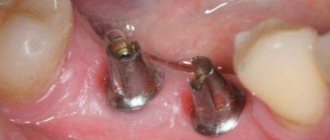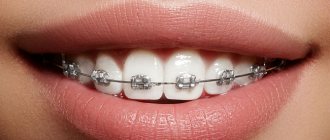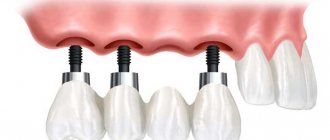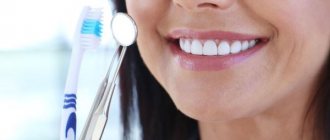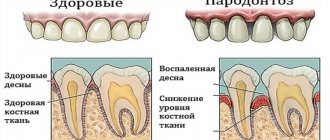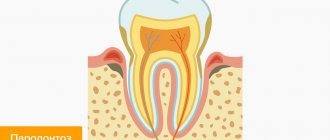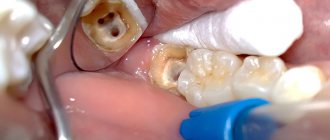“Is it possible to put braces on crowns ?” - this issue is often discussed by patients on Internet forums. Dentists themselves compare such discussions to calculating the “average temperature in a hospital.” At an advanced age, each of us is already well acquainted with the procedures for treating caries and periodontitis, and many wear various dentures in the oral cavity: single crowns, bridges or crowns installed on implants. Therefore, an orthodontic treatment plan for each adult patient is developed taking into account the existing clinical picture and characteristics of the dentition anomaly, confirmed by a panoramic photograph of the jaw.
If you decide to correct your one and only bite, sign up for a consultation with a good orthodontist. Only at a personal appointment and only after a preliminary examination can an individual solution to the problem posed by the patient be found.
Compatibility of braces and crowns: more likely yes than no
A crown is a protective shell made of various materials that covers a tooth affected and partially destroyed by caries. If the tooth root was preserved during the treatment, it is possible to deploy the prosthesis using a brace system. But before installing braces, the patient will be asked to replace the crown, which is not tightly fixed to the tooth and causes him any inconvenience. This is a prerequisite for achieving the desired result when correcting the bite.
Otherwise, the impact of the orthodontic arch will only lead to the destruction of the prosthesis, since it will not be able to move in the right direction under the influence of traction. Therefore, after removing the braces, the patient will have to repeat the procedure of taking an impression, making and installing the prosthesis.
There is one more nuance. Only metal can provide a suitable level of adhesion to the materials used to make crowns. Therefore, the patient will most likely be offered metal braces fixed on the front surface of the teeth. But even in this case, it is impossible to exclude the possibility of the bracket coming off and being reinstalled. Ultimately, the successful result of bite correction will depend on the skill of the orthodontist, who will find the optimal amount of load on the tooth restored with a crown.
Effect of orthodontic design on crowns
When correcting the dentition with dentures, some changes may occur. If the crown is placed on a tooth with a living root, it may rotate during treatment with braces. Due to the load in the form of braces, there is a possibility of mechanical damage to the crown. And this negatively affects its functionality and aesthetics. In addition, it may collapse.
Old crowns that were removed during treatment due to tooth movement may not return to their original place, then they need to be replaced with new ones. It must be borne in mind that there is a possibility that an unremoved crown will darken and become rough due to the fixing agent. Then, after the braces are removed, it must be restored or replaced.
However, you must keep in mind that the mark will still remain, so if you do not plan to replace the crowns, it is better not to install this orthodontic system on the front row. Also, there is no need to put braces only on the bottom row, since it is not possible to set the correct straight bite, and therefore there is no point in such treatment. When chewing, the upper teeth will gradually return the lower ones to their original position, and you should not expect any effect from wearing them.
Is it possible to install braces on a bridge prosthesis?
A bridge is used to restore the dentition after tooth extraction under general anesthesia or anesthesia. Due to the limited mobility of the supporting teeth on which the prosthesis is attached, orthodontic treatment becomes more problematic. In addition, the suspended part of the bridge may collapse when teeth move under the traction of the orthodontic arch. But there is still the possibility of aligning the bite. Depending on the characteristics of the bridge structure and the location of its installation, it can be removed or replaced with temporary crowns made of plastic while wearing braces, or, to avoid destruction, divided into several segments by sawing.
Patients wearing braces on dentures must especially carefully follow all the doctor’s recommendations and, first of all, minimize the mechanical impact on the system by avoiding hard and sticky foods. If the fixation of the bracket is still broken and it comes off, you should see an orthodontist as soon as possible so as not to interrupt the planned effect of the system on the entire dentition.
Is it possible to put braces on crowns, on implants, on fillings and in the absence of a tooth?
Not everyone can boast of flawless, pain-free teeth. Usually, by adolescence, a person has experience in treating at least one caries. What can we say about older people! And when wisdom comes, and with it the decision to put on braces, you can’t help but wonder: will the numerous dental work already performed in your mouth harm such an installation?
Let's talk separately about each problem - whether braces are installed on fillings, whether it is necessary and possible to put braces on crowns, whether orthodontists are willing to put braces on implants, and, finally, whether it is even possible to get braces if a tooth is missing.
Is it real – braces for fillings?
Yes, it's real! It may be true that old fillings will have to be redone - they should not have chips, cracks, etc. High-quality fillings are not a contraindication for the installation of an orthodontic system. The exception is the situation when the filling is located directly in the place where the braces should be glued. Since the main task of braces is to push and pull, they will, accordingly, simply squeeze out or pull out the filling material. If there is such a problem, the issue of placing braces on the dentition is decided exclusively on an individual basis. You should also be prepared for the fact that after orthodontic treatment, fillings will have to be redone: due to the fact that the teeth have turned and moved, they may become more noticeable, begin to bulge or crumble.
Is it possible to put braces on crowns?
Yes, and this is possible - after all, the root of the tooth under the crown remains alive, which means it may well move in the direction of the correct bite. True, there are some nuances: most likely, the orthodontist will recommend you metal braces. Their adhesion to the artificial surface of the crown will be more effective than that of “clasps” made from other materials. In addition, if all owners of braces need to be careful (avoid mechanical impact on the braces, do not eat hard and sticky food, etc.), then you will have to be doubly careful - after all, braces are not attached to crowns as reliably as on the native tooth enamel. But there is good news: even if normalizing your bite requires moving the teeth that support the bridge, you can still get braces. During treatment with braces, the bridge is either removed and replaced with temporary plastic crowns, or sawn into several spaces to avoid destruction.
Do they put braces on implants?
Yes, they do. But there will be a little more reservations here than in the previous two cases. The fact is that an implant is a completely “non-living” structure installed in your mouth. It was placed so as to fit organically into your dentition. And if the bite at the time of installation was incorrect, then the position of the implant cannot be correct. At the same time, it cannot align with living teeth - if the implant is able to move, it is only to the exit. In other words, with the pressure and load exerted by braces, it may simply fall out. Therefore, if there is such an opportunity, it is better to first correct the bite using a brace system, and then install implants. However, if they are already installed in the mouth, then the situation is also not hopeless - especially if you do not need to attach braces specifically to them.
Braces for missing teeth
It is possible to install a braces system in the absence of one or even several teeth, but it all depends on the specific case. If there are not enough “supporting” teeth – that is, those on which braces should be placed, then installing an orthodontic appliance will be difficult. The doctor will probably first suggest that you make implants that are specially designed for the upcoming load. It all also depends on your goals: for example, the desire to straighten the front incisors is feasible in most percent of cases, even if other molars are missing. But if you want to use braces to “remove” a hole in the place of a missing tooth, you will most likely get a refusal. This is a very complex orthodontic process with a poorly predictable outcome.
Expert opinion
Discussing whether it is possible to get braces if you have certain dental problems is, by and large, the same as calculating the temperature “on average in a hospital.” There are no two identical dentitions, clinical pictures and panoramic photographs! Everything is very individual, and what a good orthodontist will never offer to one patient may well be available to another. Much depends on the current condition of the teeth, how previous dental work was performed, and also on what goal the person is pursuing when choosing treatment with braces. If you want to know exactly how you can correct your personal, one and only bite, consult a good orthodontist. This is the only way to obtain reliable information.
Put braces on implants: the situation is not hopeless
In this case, only a highly qualified orthodontist can make the right decision. The alignment of “living” teeth in the correct row occurs due to the tension of the bracket system created by the orthodontic arch. When implanting an artificial root into the bone and installing a crown on it, dentists tried to organically fit the structure into the existing dentition with an abnormal bite and gave it a corresponding abnormal position. Therefore, the traction of the arc can simply pull the implant out of the bone. But even in this case, bite correction, under certain circumstances and with reservations, can be performed.
Quick appointment Free consultation
Installation of braces on fillings
It is possible to attach an orthodontic structure to filled teeth. To do this, you need to carefully inspect each seal placed. If cracks or chips are found on the surface of the old filling material, a new filling will have to be installed. If the old tabs are not damaged, you can install braces directly on top of them.
The exception is fillings placed in the place where the bite correction system is supposed to be attached. When fixing an orthodontic bracket on the surface of the filling material, due to the high load, it can collapse and break off, making further alignment of the dentition impossible. The presence of such a problem is solved by a dentist individually.
Treating a malocclusion can also cause teeth to be refilled by moving or rotating them, making the filling material more visible or causing the insert to break down.
Braces for missing teeth
A good specialist can develop an orthodontic treatment plan even in this situation - of course, if there are still supporting teeth in the oral cavity on which the braces can be attached. Otherwise, dental implantation will first need to be done while you sleep or under general anesthesia. True, the amount of possible orthodontic care in this case may not correspond to the patient’s wishes. For example, a doctor can correct the position of the front incisors, but will most likely refuse to eliminate the “gap” at the site of the extracted tooth. Such a complex procedure will take a lot of time and require significant effort, and its result, for objective reasons, may be unpredictable.
Possible risks and complications
To determine whether an artificial tooth can withstand a device for leveling rows, you need to study the clinical picture, take panoramic photographs, and look at the current state of the masticatory organs. If everything is fine, braces can be installed inexpensively. When the pathological unit is covered by a crown and the root remains alive, its movement will occur. In such a situation, the dentist will recommend a metal structure to the patient as it has an effective bond. The client will have to be careful, because the element is attached to artificial crowns more weakly than to natural enamel.
Installation of the implant does not interfere with the alignment of the rows. True, there are many restrictions here. An implant is a non-living “rudiment”. If at the time of its installation the bite was incorrect, its position is also incorrect. He won't be able to level out. Under load and pressure it will fall out or break. Therefore, first the position of the masticatory organs is corrected, and then implantation is done. If there is no need to place braces on the implants, aligning the units is quite possible.
It is a mistake to believe that a filling is an obstacle to eliminating an abnormal bite. Good material and quality work are not a contraindication. Before installing the device, the dentist must make sure that the fillings are not chipped or cracked. If defects are detected, they must be replaced. When cement is present at the place where the clip is glued, the task becomes more complicated. Since the device will pull and press, this can remove the filling material from the hollow. Therefore, the dentist decides whether to put braces on filled teeth or not. After therapy, fillings may need to be reinstalled.
Myths and truth of methods
There are many common opinions about the combination of these techniques, some of which are true, and the second are misconceptions. Here are a few of them:
- If the patient has only 2-3 crooked teeth, it is easier to remove them and install beautiful implants in their place. Theoretically, this approach is possible, but not a single good dentist will remove healthy teeth if the problem lies only in malocclusion. Braces are the best option.
- During dental treatment with braces, a tooth can be removed and replaced with an implant. This is a myth, because before installing corrective arches, the doctor excludes any diseases of the oral cavity and the risk of their development. If, in an emergency, removal is necessary, then the treatment with braces is adjusted - the specialist redistributes the load between other teeth, taking into account the freed up space - without implantation. If the braces were recently removed and the tooth had to be removed, then the correct solution is to install dentures on implants so as not to return the braces to the oral cavity.
- Braces can be placed on implants. This is true, but it is worth considering that when natural teeth move, the crown on an artificial prosthesis will deteriorate. It will have to be replaced.
- Braces are used when planning implantation. This is true. When the decision is made to place implants, often the dentition is already incorrectly displaced due to the absence of one or more teeth. The doctor first moves the teeth apart using braces, returning them to their places, and then implants the implant.
Find out the prices for dental implantation and bite correction with braces at the Healthy Teeth clinic now by calling us!
Missing tooth requiring implantation
In cases where the patient requires both implantation and teeth straightening, the latter is done first. The doctor installs braces, which help move the teeth to the side, making room for an implant with a crown.
Before treatment begins, the patient is examined by a surgeon, orthodontist and orthopedist. The first specialist will install the implant, the second will correct the bite, and the third will install the crown. Together they draw up a treatment plan, coordinating their actions. In such complex treatment, accuracy is important, so doctors must take into account all the nuances (volume of bone tissue, size of the gap in the dentition, etc.).
If you install braces without taking into account further implantation, then there may be too little space in the dentition to install an implant with a crown. Thus, the patient will have to contact the orthodontist again, and the treatment will be more complicated. Therefore, it is important to calculate everything in advance.
When installing an implant while wearing braces, the system is equipped with special springs
Sometimes the implant is installed while wearing braces. To do this, the orthodontist puts a spring on the teeth located on the sides of the gap, which does not allow them to move in the direction of the gap. While the patient wears braces, the implant will take root quietly, and after they are removed it will be possible to immediately install a crown.
To prevent the teeth located on the sides of the gap from closing it, braces with a spring are placed on them. The patient wears this design until the implant is implanted and the crown is installed.
In such cases, treatment is carried out in the following order:
- Examination and consultation with a surgeon, orthodontist and orthopedist
- Diagnostic measures
- Installation of braces
- Implantation of an implant (while wearing braces or after removing them)
- Removing the bracket system
- Crown installation
Preparing teeth for braces
The condition of the oral cavity and chewing organs must be constantly monitored. To do this, you need to regularly visit the dental office for preventive maintenance. It is very important to have timely dental treatment, align teeth, and eliminate all defects. Treatment of incisors, canines, molars and installation of an apparatus to correct the bite is carried out after careful preparation of the oral cavity.
- Orthodontic structures are placed on the treated organs. If pulpitis, caries, or other diseases are detected, they should be eliminated.
- Therapy against inflammation is prescribed if there are signs of infection so that it does not go into the acute phase.
- If you have crowns on your teeth, implants, fillings, you need to consult an orthodontist.
- Professional hygienic cleaning is required. The patient receives advice on quality oral care during orthodontic therapy.
Knowing the specifics of treatment helps to achieve better and long-term results.
